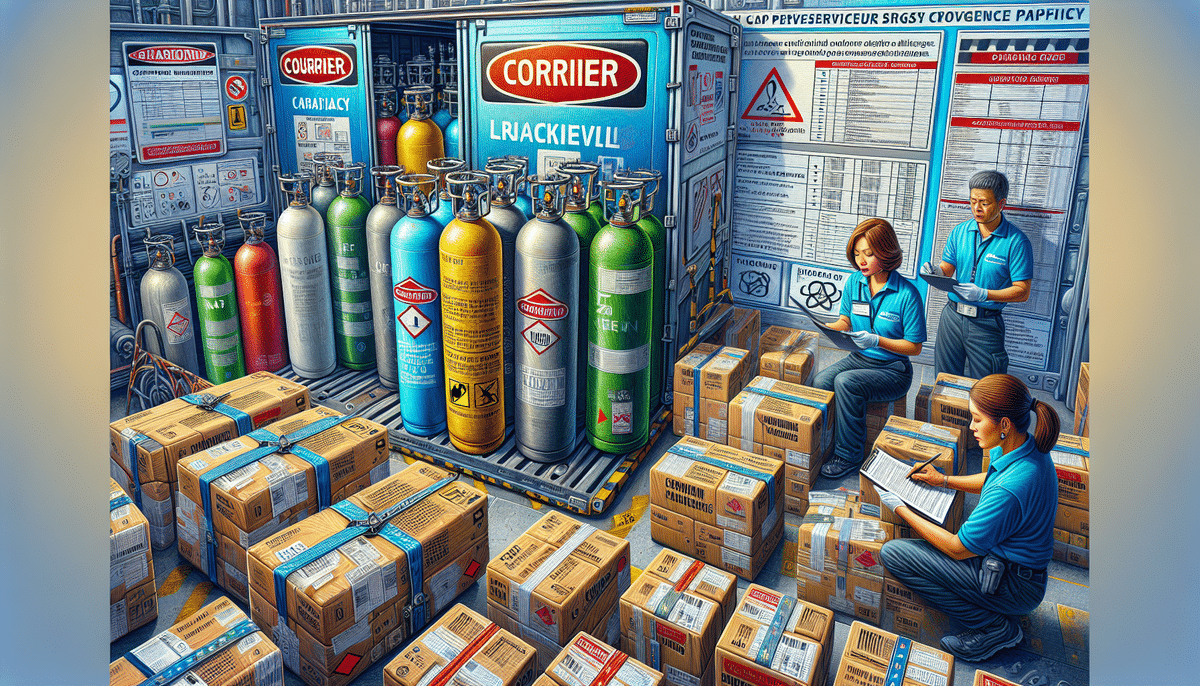Amazon Error Highlights the Perils of Shipping Hazardous Materials
Recently, Amazon faced a significant incident that underscored the dangers of shipping hazardous materials. The mishap resulted in five workers being hospitalized, exposed dozens to hazardous substances, and necessitated the evacuation of several buildings at the company's Seattle campus. This event has raised serious concerns about Amazon's safety protocols, the implications of this specific incident, and the measures needed to prevent similar occurrences in the future.
Understanding the Risks of Hazardous Materials Shipping
Shipping hazardous materials is inherently risky. These materials, which include chemical solutions and compressed gases, pose threats to human health and the environment. Proper handling, packaging, and transportation are crucial in minimizing these dangers. Employees involved in transporting hazardous materials must undergo rigorous training and certification, ensuring they comprehend the potential risks and adhere to strict safety guidelines.
Beyond transportation accidents or spills, improper disposal of hazardous materials can lead to severe environmental contamination, affecting soil and water sources. Companies must comply with regulations such as the Hazardous Materials Transportation Act and the Resource Conservation and Recovery Act. Non-compliance can result in substantial fines and legal repercussions.
The Implications of Amazon's Shipping Error
The recent Amazon shipping error involved the dangerous chemical sodium hypochlorite, known to cause skin and eye irritation, respiratory issues, and other health problems upon exposure. The hospitalization of five employees and the exposure of others underscore the potential for permanent injuries and extensive operational disruptions. With Amazon employing up to 40,000 people in the Seattle area, the scale of impact could have been much more significant.
This incident highlights the critical need for comprehensive training and robust safety protocols in handling hazardous materials. Ensuring employee and public safety requires diligent adherence to safety measures, failure of which can lead to legal actions and irreparable damage to a company's reputation.
Moreover, this error calls into question the effectiveness of current regulations and oversight mechanisms governing hazardous materials transportation. Enhanced collaboration between government agencies and industry bodies is essential to elevate safety standards and prevent future incidents.
How Amazon is Responding to the Incident
Amazon has acknowledged full responsibility for the incident. In a statement, the company confirmed that affected workers received treatment and were released, and that relevant authorities were informed. Amazon emphasized its commitment to employee safety and adherence to strict hazardous materials handling and transportation protocols.
To prevent future incidents, Amazon is conducting a comprehensive investigation to identify the root causes and implement corrective measures. Additionally, the company has introduced enhanced safety training programs developed in partnership with industry experts, incorporating hands-on training and simulations to better prepare employees for handling hazardous materials.
Amazon has also increased the frequency of safety audits and inspections across all facilities to proactively identify and mitigate potential safety issues.
The Importance of Proper Hazardous Materials Labeling
A critical factor in this incident was a labeling error by the shipper, which misidentified the package's contents and hazardous nature. Accurate labeling is paramount in the safe shipping of hazardous materials, ensuring proper handling, containment, and transportation. Even a minor labeling mistake can lead to life-threatening accidents.
Compliance with Department of Transportation (DOT) labeling regulations is not only a safety imperative but also a legal requirement. Non-compliance can result in severe fines and legal consequences.
Proper labeling also facilitates smooth transportation processes by preventing delays in customs or shipping facilities, thus ensuring efficient business operations.
Exploring the Legal Ramifications of Shipping Hazmat Incorrectly
Shipping hazardous materials entails strict legal obligations. Non-compliance with regulations can lead to substantial fines and criminal charges. Companies must adhere to guidelines regarding labeling, packaging, and documentation to avoid physical and financial damages. Any lapse can trigger extensive investigations, regulatory challenges, and costly legal battles.
Staying updated with the latest regulations and implementing robust compliance measures are essential for companies involved in hazardous materials shipping. This includes maintaining accurate documentation and having emergency response plans in place to manage potential accidents effectively.
Lessons Learned from Amazon's Mistake
This incident serves as a stark reminder of the critical importance of meticulous handling and transportation of hazardous materials. Staying abreast of regulations and maintaining stringent safety protocols are essential to prevent such mishaps. Amazon's transparent and proactive response—acknowledging the mistake, addressing it promptly, and implementing corrective measures—exemplifies best practices in crisis management.
The event also underscores the necessity for continuous training and education for employees handling hazardous materials. Regular safety audits and inspections are vital to identify and rectify potential hazards before they escalate into serious incidents.
Protecting Workers and the Public from Hazmat Exposure
The transportation of hazardous materials poses risks not only to workers but also to the general public. Ensuring proper labeling, handling, and transport protocols is essential to prevent accidental exposures that can have widespread health implications. Companies must provide comprehensive training and necessary protective equipment to workers handling these materials.
Implementing stringent regulations that govern every aspect of hazardous materials transport—from labeling to vehicle specifications—ensures that these materials are moved safely, thereby minimizing public exposure risks.
The Impact on Amazon's Reputation and Future Business Practices
Amazon has historically faced scrutiny over its labor and business practices. This hazardous materials incident compounds the challenges the company faces in maintaining a positive public image. The company's handling of this incident will be closely watched, influencing public perception and consumer trust. Transparent communication and demonstrable commitment to safety are crucial for Amazon to restore and maintain its reputation.
Tips for Safe and Effective Hazardous Materials Shipping
Shipping hazardous materials can be managed safely by following these key practices:
- Understand and comply with all regulations and guidelines related to hazardous material shipping.
- Provide comprehensive training for employees involved in handling and shipping hazardous materials.
- Ensure all hazardous material packages are correctly labeled and use appropriate packaging to contain and protect the contents.
- Implement rigorous checks to verify the accuracy of package contents before shipping.
- Develop and maintain a standard operating procedure for responding to hazardous materials incidents to ensure rapid and effective response.
The Role of Technology in Preventing Hazmat Shipping Errors
Advancements in technology can significantly reduce the risks associated with shipping hazardous materials. Automated labeling and identification systems minimize human error, ensuring accurate documentation and compliance with regulations. Additionally, online training programs and specialized software can enhance regulatory compliance and operational efficiency, further preventing accidents.
How Consumers Can Protect Themselves from Hazmat Exposure
Consumers play a role in safeguarding themselves from hazardous material exposures by staying informed about the products they purchase. Understanding the potential risks and knowing what hazardous materials are being shipped can help consumers take necessary precautions. In the event of a hazardous material incident nearby, following guidance from local authorities is crucial to minimize exposure risks.
Amazon's Responsibility in Preventing Future Hazmat Incidents
As a leading global retailer, Amazon has a paramount responsibility to ensure the safe handling and transportation of hazardous materials. This involves implementing rigorous training programs, maintaining robust safety protocols, and allocating sufficient resources to manage hazardous materials safely. Transparency in incident reporting and proactive measures to address safety concerns are essential for preventing future incidents.
The Need for Stronger Regulations and Oversight in Hazardous Materials Shipping
While companies are responsible for the safe handling and shipping of hazardous materials, government oversight is crucial in enforcing compliance and enhancing safety standards. Strengthening regulations, increasing inspection frequencies, and ensuring stringent enforcement can significantly reduce the occurrence of hazardous materials accidents.
Other Companies That Have Faced Similar Hazmat Shipping Challenges
Amazon is not alone in grappling with challenges related to hazardous materials shipping. Numerous companies have experienced accidents involving hazardous materials, highlighting the pervasive risks in this industry. These incidents emphasize the need for stringent safety measures and continuous improvements in hazardous materials handling practices across all organizations.
Conclusion
The regrettable incident at Amazon serves as a potent reminder of the inherent risks in shipping hazardous materials. It underscores the critical importance of meticulous handling, transportation, and labeling to protect both the workforce and the public. Companies must prioritize staying updated with evolving regulations, invest in employee training, and leverage technology to minimize accident risks. While Amazon's reputation may recover over time, the long-term consequences of hazardous materials accidents are profound and far-reaching, necessitating unwavering commitment to safety and compliance.






















